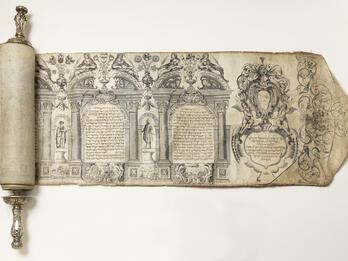A Ruling on the Printing of the Zohar
Isaac de Lattes
1558
The earth made noise as did the heavens, and the doorposts are shaking at the voice crying out that it would be wrong to publish hidden and sealed materials and to break through the fence established by the ancients who hid them in their treasure rooms and the royal store house. Since ancient days [these writings] have not been revealed. Know that…
Creator Bio
Isaac de Lattes
Isaac ben Immanuel de Lattes, the son of Bonet Lattes (physician to Pope Leo X) was born in Provence. He spent much of his life in poverty, in search of a livelihood. In 1530, he served as rabbi at Avignon. He later lived in Rome, where he managed a Hebrew printing house, and Mantua, where he worked as a printer and was involved in producing the Mantua edition of the Zohar (1558–1560). Toward the end of his life, he was employed as tutor to the sons of Isaac Abravanel and lived at the scholar’s home in Ferrara. Lattes composed many responsa, poems, and a commentary on the thirteenth-century work by Yedaiah Bedersi, Beḥinat ‘olam (Examination of the World).
Related Guide
Jewish Printing and Book Culture
Jewish printing unified far-flung communities by standardizing religious texts, created textual uniformity, and enabled vernacular translations, and facilitated the spread of Jewish texts and knowledge.
Related Guide
Early Modern Italy: Where East and West Meet
Ashkenazim, Sephardim, and Marranos encountered each other in Italian cities, developing community structures that later influenced Jewish communal organization throughout the western world.
Related Guide
Early Modern Jewish Languages
As Ashkenazi and Sephardi Jews migrated eastward, Yiddish and Ladino emerged as distinct languages. Both languages developed literary traditions, as print became more widespread.
You may also like

“Hayya Ga’on’s” Pitron ḥalomot (Dream Interpretation)
Colophon: Zohar (Mantua Edition)
Colophon: Tikune ha-Zohar (Mantua Edition)

Responsum: On Printed Megilot (Scrolls of) Esther



